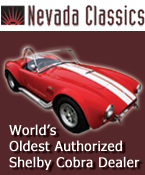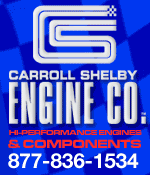 
 Main Menu
Main Menu
|
 Nevada Classics
Nevada Classics
|
 Advertise at CC
Advertise at CC
|
 March 2025
March 2025
|
| S |
M |
T |
W |
T |
F |
S |
| |
|
|
|
|
|
1 |
| 2 |
3 |
4 |
5 |
6 |
7 |
8 |
| 9 |
10 |
11 |
12 |
13 |
14 |
15 |
| 16 |
17 |
18 |
19 |
20 |
21 |
22 |
| 23 |
24 |
25 |
26 |
27 |
28 |
29 |
| 30 |
31 |
|
|
|
|
|
|
 CC Advertisers
CC Advertisers
|
|

09-30-2002, 08:37 AM
|
|
CC Member

|
|
|
Join Date: May 2002
Location: San Diego,
CA
Cobra Make, Engine: SPF - 427 Stroker
Posts: 721
|
|

 Not Ranked
Not Ranked
 Dyno Tune Motor
Dyno Tune Motor
How hard on your motor is it to have it dyno tuned ? I know it is much better to tune the motor under load but I have also heard that it is quite hard on it. Is this true ? Also, what questions should I ask the shop to determine if they are any good and know what they are doing as opposed to just running it hard and finding out how much power it has ? Basically, what are the things I should be looking for when doing this ?? I am looking at JBA racing in San Diego. Has anyone ever used them ? Thanks in advance.
__________________
NEVER LIFT
|
-
Advertising


09-30-2002, 08:59 AM
|
 |
CC Member

|
|
|
Join Date: Apr 2001
Location: San Diego,
CA
Cobra Make, Engine:
Posts: 1,112
|
|

 Not Ranked
Not Ranked
That's where I am taking mine. There's another place in Santee, but I felt comfotable with JBA, especially since the owner has a Tunnel-port, like I do.
You're going to run your car at least that hard on the track. I run my car that hard on the street, so IMHO, not a big deal as to engine strain.
__________________
Bill Malone
Gashole
CSX4786
|

09-30-2002, 11:12 AM
|
|
CC Member

|
|
|
Join Date: May 2002
Location: San Diego,
CA
Cobra Make, Engine: SPF - 427 Stroker
Posts: 721
|
|

 Not Ranked
Not Ranked
Ever heard of GodSpeed in Carlsbad/Oceanside ?? They look good as well...
http://www.teamgodspeed.com/index.htm
__________________
NEVER LIFT
|

09-30-2002, 11:53 AM
|
 |
CC Member

|
|
|
Join Date: Apr 2001
Location: San Diego,
CA
Cobra Make, Engine:
Posts: 1,112
|
|

 Not Ranked
Not Ranked
Sorry, don't know anyone who has used this shop.
Have you joined the local SAAC club yet? You get a deal on dyno time. Think it is for the shop in Santee (The Dyno Shop).
__________________
Bill Malone
Gashole
CSX4786
|

10-01-2002, 05:35 PM
|
 |
CC Member

|
|
|
Join Date: May 2000
Location: Vacaville, CA, USA,
Posts: 149
|
|

 Not Ranked
Not Ranked

Luke,
Make CHP prove it - who do they recommend?
Having your motor dyno'd serves a number of purposes;
1) If its going to blow up, its going to do it early. Might as well be on the stand and not in the car.
2) Some say you should take it easy the first few thousand miles then get on it. I say stand on it - if it breaks it needed replacing anyway. I babied my old motor and it spun a bearing - twice. Damn wimp motor! I have seen John Force's team out rebuilding his funny car egine between races. He sure isn't taking it easy when the green flag drops!
3) Prove the numbers the builder tells you his motor will make. HP and torque are mystical numbers that everybody lies about. If they tell you it will make 500 HP - have them prove it.
That said, there really is no other place that you can see the results of the work you do to the engine other than the dyno. They don't necessarily tune it while it is running. They might shut it down, let it cool, and make some carb or timing adjustments. Then they fire it back up and see what new numbers it will make. Most dyno operators like to play, and see if they can extract a little more power. But, for every hour your motor is on the dyno, its going to cost money. So you have to decide when enough is enough.
Brad

|

10-01-2002, 05:57 PM
|
|
CC Member

|
|
|
Join Date: May 2002
Location: San Diego,
CA
Cobra Make, Engine: SPF - 427 Stroker
Posts: 721
|
|

 Not Ranked
Not Ranked
Thanks Brad...The motor is plenty powerful for me the way it is. Runnig such high compression I just want to make sure it is tuned properly and find out exactly how much power it is putting down. It was dynoed before going in the car at 607hp if I remember correctly, but there was no load on it. I want to see what it makes at the rear wheels under load. I think it will be fine once we get the heads back on - the motor seems very strong otherwise, but who knows...I guess we will see. Thanks again.
Oh yea, was it a CHP motor that spun the main >??
__________________
NEVER LIFT
|

10-01-2002, 06:02 PM
|
|
CC Member

|
|
|
Join Date: Sep 2002
Posts: 39
|
|

 Not Ranked
Not Ranked
Brad, excelent post!
I used to have my boat engines (twin chevy small blocks 450 H.P) rebuilt each winter and dyno tuning was required as they drove matched pumps instead of props. I would MUCH rather see a failure on the stand then after the labor of installing them.
If either engine failed during dyno testing, the engine builder was getting it back on his dime!
|

10-02-2002, 04:51 AM
|
 |
CC Member

|
|
|
Join Date: Nov 1999
Location: Brisbane, Australia,
Q
Cobra Make, Engine: Contemporary CCX3117 427FE
Posts: 4,381
|
|

 Not Ranked
Not Ranked
Quote:
Originally posted by agro1
It was dynoed before going in the car at 607hp if I remember correctly, but there was no load on it. I want to see what it makes at the rear wheels under load.
|
Agro - an engine dyno places more load on an engine than a chassis dyno could ever hope to. It's for this reason that all serious race teams have engine dynos. It's a far more reliable, repeatable and accurate way of tuning a motor.
__________________
Craig
|

10-02-2002, 08:31 AM
|
|
CC Member

|
|
|
Join Date: May 2002
Location: San Diego,
CA
Cobra Make, Engine: SPF - 427 Stroker
Posts: 721
|
|

 Not Ranked
Not Ranked
Craig - Please explain...How can "load" be placed on a motor by an engine dyno when the entire rotating assembly is turning only it's own mass and nothing else ?? I could be way off base here, but it is my understanding that only on a chassis dyno do you have the load of the flywheel, clutch assembly, pressure plate, gearbox, driveshaft, rear-end, wheels...Or maybe I am wrong...Wouldn't be the first time.
__________________
NEVER LIFT
|

10-02-2002, 09:19 AM
|
 |
CC Member

|
|
|
Join Date: Mar 2002
Location: so cal,
Cal
Cobra Make, Engine: I used to fix them for a living
Posts: 2,563
|
|

 Not Ranked
Not Ranked
An engine stand has a motor running without anything attached to it. An engine dyno bolts up to the flywheel of the motor being tested and does put a load on the motor, usually using a water brake. A chassis dyno requires that the tires get enough traction on the big roller to load the motor.
__________________
In a fit of 16 year old genius, I looked down through the carb while cranking it to see if fuel was flowing, and it was. Flowing straight up in a vapor cloud, around my head, on fire.
|

10-02-2002, 09:21 AM
|
|
CC Member

|
|
|
Join Date: May 2002
Location: San Diego,
CA
Cobra Make, Engine: SPF - 427 Stroker
Posts: 721
|
|

 Not Ranked
Not Ranked
FIXIT - So which puts more load on the motor ?
__________________
NEVER LIFT
|

10-02-2002, 09:28 AM
|
 |
CC Member

|
|
|
Join Date: Mar 2002
Location: so cal,
Cal
Cobra Make, Engine: I used to fix them for a living
Posts: 2,563
|
|

 Not Ranked
Not Ranked
A chassis dyno require that the tire grip the big wheel, An engine dyno BOLTS up to the flywheel. Higher output motors sometimes cannot get enough traction on the "big roller wheel" of the chassis dyno to prevent slippage. An engine dyno can also put more load on the motor since it has a friction device, where as the chassis dyno, you just accelerate a big mass and then extrpolate "work" done in an amount of time. I don't think there's a chassis dyno out there that can accuratly measure 1000 hp motors, the tires would spin. But there are flywheel dynos that can.
__________________
In a fit of 16 year old genius, I looked down through the carb while cranking it to see if fuel was flowing, and it was. Flowing straight up in a vapor cloud, around my head, on fire.
|

10-02-2002, 09:36 AM
|
|
CC Member

|
|
|
Join Date: May 2002
Location: San Diego,
CA
Cobra Make, Engine: SPF - 427 Stroker
Posts: 721
|
|

 Not Ranked
Not Ranked
Gotcha - thanks for the reply. What are the important things to look for on a chassis dyno ? I mean, what type of connections, sensors, etc do I need to make sure the shop uses for an accurate reading ? This particular place (JBS RACING in San Diego) has one that measures almost all vital engine functions, egt, o2 sensor, air/fuel, etc...They also can adjust the rollers to the vehicle weight (is this a good thing?). What would the weight of a small block prepared SPF be ? Thanks again.
Luke
__________________
NEVER LIFT
|

10-02-2002, 10:50 AM
|
 |
CC Member

|
|
|
Join Date: Mar 2002
Location: so cal,
Cal
Cobra Make, Engine: I used to fix them for a living
Posts: 2,563
|
|

 Not Ranked
Not Ranked
I really don't know much about chassis dynos. All real engine devolopment is done on engine dynos. In my opinion, chassis dynos are mostly for selling people tune up services (which often are unneeded) and a piece of paper with a number on it for their ego. If I could only monitor one variable on a motor while on a dyno, it would be exhaust gas temperature.
__________________
In a fit of 16 year old genius, I looked down through the carb while cranking it to see if fuel was flowing, and it was. Flowing straight up in a vapor cloud, around my head, on fire.
|

10-02-2002, 10:53 AM
|
|
CC Member

|
|
|
Join Date: May 2002
Location: San Diego,
CA
Cobra Make, Engine: SPF - 427 Stroker
Posts: 721
|
|

 Not Ranked
Not Ranked
Agreed....
__________________
NEVER LIFT
|

10-02-2002, 05:13 PM
|
|
CC Member

|
|
|
Join Date: Nov 2001
Location: P. O. Box 96, CATAUMET, Massachusetts 02,
MA
Cobra Make, Engine: Butler with home-rebuilt 393 Cleveland stroker(Ya---ikes!)
Posts: 3,036
|
|

 Not Ranked
Not Ranked
Mr. Fixit,
Could you elaborate a bit on the exhaust temperature's importance? What does it indicate---complete burning of gasses or something like that? Also one guy I know says that engines can be rated on Kilowattage (or some such electrical criteria). Is that relevant or accurate?
__________________
Freddie
|

10-02-2002, 06:22 PM
|
 |
CC Member

|
|
|
Join Date: May 2000
Location: Vacaville, CA, USA,
Posts: 149
|
|

 Not Ranked
Not Ranked

Luke, et al,
An engine, on a stand, unloaded, is nothing more than a very expensive fan!
I used the term 'stand' earlier in speaking of the engine dyno stand. What I meant to say was - "It would be better to have an engine come apart on the engine dyno stand than in the car".
There are folks who put their engine on a stand and run it - only to put time on the engine, break it in, or look for leaks - but this is not a dyno.
Luke - to understand the 'force' an engine can generate, it has to work against resistance. No resistance, and its just running (a fan!). Add resistance and you can measure the force. Most of the engine dyno's I have seen use a water to create resistance against the turning power of the engine. Once the engine is up to proper operating temp, the dyno operator will open a water valve to load resistance against the engine. How the engine responds is measured. Torque is the twisting power that is measured, and horsepower is calculated from the torque numbers. These numbers come directly (Direct) from the engine and are more exact. On a chassis dyno, the tires, axle, rear-end, driveshaft and transmission all tax the power a bit, OR act as a buffer on load placed on the engine (Indirect). You have probably seen a couple of posts on "corrected" dyno numbers where folks try to figure out true engine torque or HP (Direct) from the chassis or indirect numbers they have gotten. Generally, there is a 15 - 25% difference.
Now for Fred question, and how it relates - When you load resistance against the motor, the motor has to work. What the motor does against the load is important, hence your questions about tuning. A motor that runs fine without load may stumble under load if it is either too rich or too lean - a fact that will declare itself in the EGT. If I remember right, a lean engine will drive up the EGT under load.
Does that help?
Brad
Last edited by Brad Pfeifer; 10-02-2002 at 08:32 PM..
|

10-02-2002, 06:31 PM
|
|
CC Member

|
|
|
Join Date: Nov 2001
Location: P. O. Box 96, CATAUMET, Massachusetts 02,
MA
Cobra Make, Engine: Butler with home-rebuilt 393 Cleveland stroker(Ya---ikes!)
Posts: 3,036
|
|

 Not Ranked
Not Ranked
It certainly does. I for one (there may be more) enjoy "going to school" on this site. Thanks.
__________________
Freddie
|

10-02-2002, 08:45 PM
|
 |
CC Member

|
|
|
Join Date: May 2000
Location: Vacaville, CA, USA,
Posts: 149
|
|

 Not Ranked
Not Ranked

Fred - Ask a little, learn a little, teach a little!
I remember seeing exhaust manifolds that were almost glowing red hot, and remember being told that the motor was running way too lean. Thats how I connected increased temp and lean. I hope I got it right!
Regarding the other part of your question - can engine power be linked to kilowattage or the sort - yes, it can. The idea of torque and horsepower was developed by James Watt. He was a British inventor whose claim to fame was the steam engines he built. Since horses did much of the work at the time, he needed to find a way to relate the work his steam engines did to the work a horse did (Horsepower - I know you saw it coming!)
Anyway, he came up with a formula to figure out horsepower - torque times rpm, divided by 5252 equals horsepower. 5252 is the number he came up with based on his experiments, and is a constant. Whats interesting here is that no matter how bad of an engine or how small of an engine you are building, horsepower and torque will always be the same at 5252 rpms!
The little I learned.
Brad

|

10-02-2002, 10:40 PM
|
|
CC Member

|
|
|
Join Date: Oct 2000
Location: Crystal Lake,
IL
Cobra Make, Engine: Everett-Morrison, 434 cid
Posts: 977
|
|

 Not Ranked
Not Ranked

Brad,
Good point about the the exhaust glowing. The reason it's glowing is because fuel is burning in the header instead of in the cylinder. Rich is one reason for this, if it's lean it burns before reaching the header. Ignition timing that is retarded from where the engine makes peak power will also cause this, sending EGT to the moon. Exhaust valve timing too early? Same thing.
Also, a more efficient combustion chamber will have lower EGT, but higher cylinder temps. By turning more fuel in to heat in the cylinder, the exhaust temps are cooler. You could see a difference of 200 deg. on EGT for two perfectly jetted engines because of differences in combustion chamber efficiency.
A stoichiometric mixture produces the highest temperature from gasoline, makes the most cylinder pressure, and produces the most power. Going rich or lean from there drops temp, pressure, and power. The lower the exhaust temp is at stoichiometric the more heat is being converted into pressure an thus power and the less fuel is being wasted as heat out the exhaust.
Scott

|
 Posting Rules
Posting Rules
|
You may not post new threads
You may not post replies
You may not post attachments
You may not edit your posts
HTML code is On
|
|
|
All times are GMT -7. The time now is 04:56 PM.
|

















 Linear Mode
Linear Mode



